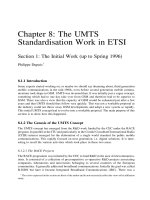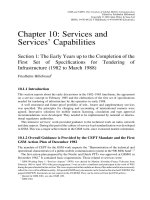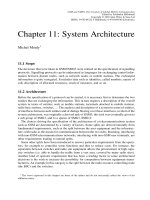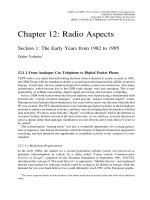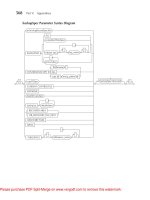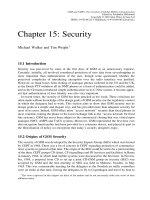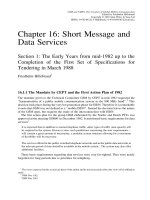GSM and UMTS (P13)
Bạn đang xem bản rút gọn của tài liệu. Xem và tải ngay bản đầy đủ của tài liệu tại đây (193.86 KB, 29 trang )
Chapter 13: The Subscriber
Identity Module: Past, Present
and Future
Klaus Vedder
1
13.1 Introduction
Since its conception in 1988 the Subscriber Identity Module (SIM) has undergone continuous
development extending its technical and functional capabilities. Initially, it was defined as a
security module to authenticate the user to the network providing, at the same time, some very
limited amount of memory for network and private user data. In those days, smart cards were
still in their infancy. The technological and market requirements of GSM, its need for a global
solution and its growing market power shaped the face of the SIM and changed the world of
the smart card. Today’s SIMs offer more than just security. They are a secure platform for
operator defined services allowing operator differentiation by exploiting the power of the
microcomputer in the SIM. All this could not have been achieved without the close co-
operation of all parties involved in its standardisation.
13.2 The Committee
From a dozen participants at the first meetings in 1988 to about 70 delegates at the last
meeting in January 2000 reflecting the growing importance of the SIM:
SIMEG, SMG9 ‘‘SIM Aspects’’ and SMG9 ‘‘IC Card Aspects’’.
Three names and only two chairmen for one committee which in 56 ordinary plenary and
hundreds of working party and ad-hoc meetings:
†
defined the Plug-in SIM, which has become the best-selling smart card;
†
required the use of high temperature plastic material to support the new environment;
†
specified new and advanced electrical and physical parameters such as low power
consumption and the 3 V smart card interface; and
†
advanced the SIM from a security and storage device to a secure platform for value added
services.
1
The views expressed in this chapter are those of the author and do not necessarily reflect the views of his
affiliation entity.
GSM and UMTS: The Creation of Global Mobile Communication
Edited by Friedhelm Hillebrand
Copyright q 2001 John Wiley & Sons Ltd
ISBNs: 0-470-84322-5 (Hardback); 0-470-845546 (Electronic)
The first meeting of the Subscriber Identity Module Expert Group (SIMEG) was hosted
by the Dutch PTT in January 1988. SIMEG had been established as an expert group by
GSM-WP1
2,3
to deal with all issues concerning the SIM and its interface to the mobile, thus
covering a specific issue within the scope of its parent body, Working Party 1 (WP1), which
was responsible for developing the GSM services. The first change in name and status was
in April 1994 when, reflecting the importance of the SIM for the GSM system, the plenary
meeting of TC SMG
4
held in Regensdorf, Switzerland ‘‘ decided to raise the group of
experts dealing with the specifications of the Subscriber Identity Module to the status of
an STC’’ . As a Sub Technical Committee (STC), SMG9 reported now directly to TC SMG,
the technical committee responsible for the specification of GSM and UMTS.
5
SIMEG had
become STC SMG9 ‘‘ SIM Aspects’’ . Four years later in June 1998, SMG9 changed its
name from ‘‘ SIM Aspects’’ to ‘‘ IC Card Aspects’’ . The scope of SMG9 had been extended
to include work on smart cards of a generic nature which had been part of the responsibility
of the disbanded TC ICC (Integrated Circuit Cards). With the foundation of the Third
Generation Partnership Project (3GPP) in late 1998, the UMTS work of SMG9 was trans-
ferred to the USIM group within 3GPP and the future of SMG9 seemed to be quite
predictable. It was assumed that all the work of SMG9 would, eventually, be transferred.
The emerging need for a common smart card platform for the various mobile communica-
tion systems created a completely new scenario. SMG9 was ‘‘ closed’’ by the ETSI Board on
29 March 2000 to be succeeded by ETSI Project Smart Card Platform (EP SCP). This
committee inherited the generic work of SMG9 as part of its task to specify such a common
smart card platform. The GSM specific work of SMG9 was handled by the new committee
on an interim basis until a few months later, with the closure of TC SMG, all GSM work
was transferred to 3GPP.
13.3 The Early Years
The first SIMEG plenary meeting in January 1988 was attended by nine delegates from
France, Germany, The Netherlands and the UK. These countries formed the core of the
plenary meetings of SIMEG for the first few years with Finland and Sweden contributing
extensively through their work in ad-hoc meetings. The chairman of the first meeting was
Ge
´
rard Mazziotto from France Telecom – CNET. He held this position for 5 years until his
resignation at SIMEG#31 in March 1993. By then the number of delegates attending the
usually 1 or 2 day plenary meetings had stabilised to around 20 from seven countries.
The plenary reports of those days often refer to the opinion of a national delegation.
Industry experts attended courtesy of the (national) operators and only two industry delegates
per country were allowed at a meeting. Industry contributions often stated the respective
national administration as the source. This was, for instance, the case with the first document
proposing what today is known as the Plug-in SIM. The description of a semi-permanent SIM
GSM and UMTS: The Creation of Global Mobile Communication342
2
Folder B4 of the attached CD ROM contains a content list covering all documents quoted in this chapter sorted
according to footnote numbers. Folder B4 contains most documents quoted. For the others a folder number is given in
the content list.
3
GSM-WP1 217/87 rev1 (GSM 159/87): Draft terms of reference of the SIM expert group.
4
With the inclusion of UMTS into its work program, ETSI TC GSM (the former Group Spe
´
cial Mobile) became
the Technical Committee TC SMG (Special Mobile Group). GSM1 (the former GSM-WP1) became SMG1 etc. The
first SMG plenary (SMG#1) was held in January 1992.
5
Scope of SMG9 ‘‘ SIM Aspects’’ in SMG 477/94: Terms of references of TC SMG and its STCs.
based on the IC card SIM was presented at SIMEG#5 in Munich in September 1988 by the
author; it was sourced ‘‘ Deutsche Bundespost’’ .
6
This situation gradually changed and, with
the transfer of the GSM specification work from the European Post and Telecommunication
Authorities (CEPT) to ETSI in the summer of 1989, industry could attend the meetings in
their own right.
The first years were obviously dominated by the need to specify the basic functionality and
physical features of the SIM and its interface to the mobile. The original role of the SIM was
that of a security device as defined in the report of SIMEG#1
7
:
A SIM is the physically secured module which contains the IMSI, an authentication algorithm,
the authentication key and other (security related) information and functions. The basic function
of the SIM is to authenticate the subscriber identity in order to prevent misuse of the MS (Mobile
Station) and the network.
This understanding of the function of the SIM underwent quite an evolutionary process
which was, however, not always reflected in the requirement specification, GSM 02.17
Subscriber Identity Modules (SIM), functional characteristics. There was often the question
of what was first: the technical realisation of a feature or the definition of the functional
requirement. Though the document was revised intensively several times, it is no easy read-
ing to gain an overview of the full functionality of the SIM.
13.4 Functionality, Form and Interface
To fulfil its role as an authentication device bringing a new dimension of security to mobile
communication networks,
8
the SIM had to be able to execute internally the operator specific
authentication algorithm (A3) and to store securely the subscriber specific key (Ki) and other
parameters needed for this task. Additional functionality, the physical forms of the SIM and
its interface to the mobile were the three main topics for quite a few years.
13.4.1 Functionality
At the third meeting in May 1988, SIMEG discussed for the first time that the SIM should
also store data related to services and not only those data necessary for the security func-
tions. Advice on this issue as well as on the creation of a new specification on SIM
communication – which was later to become GSM 11.11 – was sought from the parent
committee. GSM-WP1 supported the request from SIMEG and decided that the SIM should
offer the capability to store information elements for the following features: Short Message
Service (SMS), Advice of Charge (AoC), Abbreviated Dialling Numbers (ADN), Fixed
Dialling Numbers (FDN), barring of outgoing calls, pre-programmed PLMN selector and
language of announcement.
9
New data-fields on the SIM as well as new procedures for the
interface between the SIM and the Mobile Equipment (ME) needed to be specified, while
the constraints imposed by the memory provided by the special chips used in a SIM were a
constant source for discussion.
Chapter 13: The Subscriber Identity Module: Past, Present and Future 343
6
SIMEG 72/88: Semi-permanent SIM.
7
SIMEG 28/88: Report of the 1st SIMEG meeting, The Hague, 19-20 January 1988.
8
See Chapter 15: Security.
9
WP1 162/88, SIMEG 47/88: Letter from WP1 at SIMEG#4.
13.4.1.1 The Influence of the Memory
Memory was a scarce resource. The chips of those days offered less than 10 kbytes of memory
in total. Though the functionality and internal organisation of the chip in a SIM with its own
CPU and on-board memory is comparable to a PC, it is not surprising that the performance of
such a microprocessor chip is limited. State of the art chips had about 6 kbytes of mask-
programmed Read Only Memory (ROM). This type of memory is used for data which are the
same for a large number of cards as it cannot be changed. It typically contains the operating
system and the GSM application including authentication algorithm(s) and application proto-
col. The 2–3 kbytes of programmable memory, so-called EEPROM, would hold all the
subscription and user (thus SIM) specific data such as the IMSI
10
and the secret, subscription
specific key (Ki) for the authentication of the subscriber to the network as well as all the
subscriber information now to be stored in the SIM. A typical SIM of those days supported
the storage of about 20 abbreviated dialling numbers with 6-10 characters for each name and
five short messages in addition to those data. The Random Access Memory (RAM) which is
the ‘‘ working memory’’ was not even big enough to store all of a short message when this was
transferred from the memory in the mobile equipment to the EEPROM in the SIM. The skills
of the engineers when writing SIM software were constantly challenged and more than once it
was a question of just a few bytes as to whether an extension of the functionality would fiton
the chip or further optimisation of all the software would be required.
Neither the huge success of GSM, nor the role of the SIM as the driving force for the smart
card industry were foreseen in those days, rather the opposite opinion prevailed. The attitude
of ‘‘ order a few million microprocessor chips and we may think about developing a product’’
may have been an extreme position around the turn of the 1990s but certainly an indication of
the general feeling. So it is not surprising that chip manufacturers were reluctant to introduce
new technologies and that it took until the mid-1990s for chips with just 8 kbytes of EEPROM
to become available. Those chips offered storage for about 100 abbreviated dialling numbers
and 20 short messages. The tremendous increase in the number of GSM subscribers at that
time and GSM becoming by far the largest smart card consumer had a significant impact on
the development of new smart card chips. Today’s chips offer over 100 kbytes of ROM, 64
kbytes of programmable memory, a few kbytes of RAM and often extra hardware for the
execution of public key algorithms. This makes, in particular, the implementation of public
key solutions for mobile commerce now a reality. Furthermore, the introduction of new types
of memory such as flash memory will break up the ‘‘ historic’’ separation into ROM and
EEPROM and lead to new ways in the handling of SIMs and its software management.
13.4.1.2 PIN Management and Other New Security Features
March 1988 (SIMEG#2) saw the cipher key generation algorithm (A8) become part of the
security functionality of the SIM. A8 generates the cipher key, Kc, which is then used by the
cipher algorithm (A5) residing in the ME for the ciphering of the radio interface. It was now
up to the operator, as the party responsible for the SIM, to choose the algorithm and thus the
quality of the cipher key, Kc. Typically, A8 and the authentication algorithm A3 are
combined into one algorithm denoted by A3/8. As 10 of the 64 bits of Kc were set to zero
the ‘‘ effective key length’’ was 54 bits (though from a cryptographic point of view a key with
GSM and UMTS: The Creation of Global Mobile Communication344
10
IMSI: International Mobile Subscriber Identity. This number uniquely identifies a network and the subscriber.
several bits set to zero is not necessarily more ‘‘ effective’’ than a ‘‘ full length’’ 64 bit key). As
the mobile and the base station system were not supposed to manipulate Kc but use it as
received from the SIM and the Authentication Centre of the subscriber’s home network
respectively, the ‘‘ effective key length’’ could be controlled by the operator. Some equipment
manufacturers had, however, interpreted the specifications differently. The issue was finally
clarified by SMG#30 in November 1999 where the original meaning was confirmed.
User access to the SIM as a medium to provide GSM service is controlled by a Personal
Identification Number (PIN). This number can be changed and freely chosen by the user
within the range of 4-8 digits. The introduction of new features created a new security
scenario as the user of the SIM might not be the subscriber. Typical examples at the time
were lorry drivers using SIMs with fixed dialling numbers controlled by the fleet manager and
SIMs supporting advice of charge with a spending limit set in the card by a parent. As the
driver should not necessarily be able to edit the numbers or the child to reset the spending
limit, a ‘‘ super-PIN’’ needed to be specified to protect the contents of the new data-fields
against unauthorised changes. As neither of these two features was completed for phase 1, the
super-PIN became a phase 2 item. Before its introduction in September 1991 at SIMEG#23, it
was renamed PIN2 to emphasise the fact that it was not superior to the normal PIN, but of a
similar nature, accessing data-fields compared with accessing an application.
PIN Unblocking Keys (PUKs) had been introduced by SIMEG as another hitherto
unknown feature. The PUK provides the user with a means to reactivate the corresponding
PIN which had previously been blocked by wrong PIN entries. The actual process of keying
in a PIN with the subsequent verification by the SIM is, however, not mandated by the
specifications. These allow disabling of the check of the PIN altogether (though not of
PIN2) subject to the discretion of the operator who has to find the right balance between
security and ease of use for its specific clientele or group of subscribers. As this feature is
programmed during the personalisation of the SIM, it can be set on a per SIM basis as
specified by the operator.
An interesting interaction between PIN check and security is the order in which the PIN
check and the authentication of the SIM by the network are performed. Doing the PIN check
first, as introduced by SIMEG#32 in May 1993, has two advantages. The prompt for the user
to key in the PIN comes immediately after the mobile has been switched on, and not after the
log-on to the network which may take some time in particular when roaming. It also mitigates
the possibility of a cryptographic attack against the (SIM specific) secret subscriber authen-
tication key of a stolen SIM as the correct PIN of the ‘‘ interrogated’’ SIM would have to be
presented to the SIM prior to the delivery of the authentication challenges (unless the PIN
check is disabled). Such attacks briefly surfaced in spring 1998.
11
13.4.2 Physical Form or Realisation of the SIM
The functional splitting of the MS into ME and SIM was described in GSM-WP1 document
173/87.
12
Three different types of SIMs had been identified for specification: fixed, removable
and contained in an IC card.
Chapter 13: The Subscriber Identity Module: Past, Present and Future 345
11
SMG 475/98: Statement by SMG9 and SMG10 chairmen; see also Chapter 15: Security.
12
GSM-WP1 173/87: Functional Split of MS into ME and SIM.
13.4.2.1 The ID-1 Card
The first mobile network to employ a smart card for the authentication of the subscriber to the
network was the analogue network Netz-C of the Deutsche Bundespost (later Deutsche
Telekom). This subscriber card had evolved from a ‘‘ magstripe device’’ just like a credit
card, via a card having a memory chip containing the subscription details, to an IC card
containing a microprocessor chip for authentication and other purposes. As such smart cards
were already deployed in the field, it was not surprising that this solution was also adopted for
GSM.
Looking at it from today’s perspective, it is interesting to note how much time was devoted
to certain aspects of the IC card or ID-1 SIM (ID-1 is the standardised name for cards having
this format). It was generally assumed that most SIMs would have this format and that they
might also be used as, say a payment card outside the mobile.
For this reason ID-1 SIMs were allowed to be embossed like a credit card and even today
the slot of an ME supporting an ID-1 SIM has to be designed to cater for an embossed SIM.
No such SIM saw a subscriber. With the change of the business model, the SIM manufac-
turers stopped the extensive and mostly unsuccessful testing. The new card material needed to
satisfy the high temperature requirements of GSM imposed on the SIM, was not really suited
for embossing. The tests resulted, in most cases, in pretty warped cards.
A much discussed and thought to be typical scenario for the SIM was its use in a car phone.
How much contact pressure needed to be exerted by the card reader in the phone to the SIM
contact area so that communication between the card and the car phone would work under
‘‘ extreme driving conditions’’ ? It was also assumed that people might own a SIM and no
phone, or just travel with a SIM. A subscriber enters a taxi, which has a GSM phone in the
boot with an in-built plug-in SIM, and uses his or her own ID-1 SIM in the telephone receiver
in the back of the taxi to make a call to be charged to this SIM. These thoughts and scenarios
are behind the requirement that an ID-1 SIM takes precedence over the plug-in SIM as stated
in GSM 02.17 until June 1998 when, in connection with the specification of a second card
reader driven by the SIM application toolkit, the choice for the precedence was left to the
user. Interestingly enough, similar ideas are now discussed by 3GPP for car pooling and
access to multi-media devices from each seat in a car.
13
The reality was different. More and more ID-1 SIMs were delivered ‘‘ pre-punched’’ so that
the user could break out the plug-in SIM. Though overall market figures are not available, it
can be deduced from the numbers of a major operator that as early as 1995 the number of pre-
punched SIMs exceeded the number of ID-1 SIMs, with this number approaching nearly
100% of the total SIM market in 1998.
These were also the days of the manufacturers of punching machines and Plug-in adapters
whose products transformed ID-1 SIMs into Plug-in SIMs and vice versa. These adapters
were clearly outside the relevant GSM specifications with respect to thickness, bending and
torsion. Nevertheless, they were widely used. SMG9 was even asked by the Terminal Work-
ing Group (TWG) of the GSM MoU to specify an adapter. This was rejected by the SMG9
plenary meeting in March 1996 on grounds of violation of its core documents and potential
liability issues. Also outside the GSM specifications was the use of a ‘‘ pre-punched’’ SIM as
an ID-1 SIM in a mobile requiring the latter. Special punchings were, however, developed
around 1996 to minimise the risk of damaging the card reader in the mobile when a pre-
GSM and UMTS: The Creation of Global Mobile Communication346
13
TP-010066: UE functionality split over physical devices, TSG-T#11, Palm Springs, March 2001.
punched SIM was inserted or removed. The potential damage consisted of the contacts of the
card reader falling into the gap between the plug-in part and the remaining part of the ID-1
SIM thus getting torn, resulting in an unusable telephone. Operators had quite an interest in
such solutions as this drastically reduced their logistic problems and cost – one instead of two
types of SIM.
13.4.2.2 The Fixed Solution
The ‘‘ fi xed’’ SIM was a major topic at SIMEG#2 in March 1988.
14
This solution meant that all
functions of the SIM including the (secret) operator specific authentication algorithm and the
secret subscription specific key used for the authentication of the subscriber, would be an
integral, thus fixed, part of the mobile. Such mobiles would be operator and even subscriber
specific.
SIMEG agreed that this solution would have severe disadvantages with respect to flex-
ibility and security. Apart from the question of whether secret keys could be stored securely
in a mobile, considering all the issues around the storage of the IMEI, a fixed solution would
require a loading mechanism for the authentication algorithm and the secret subscriber key
as well as a mechanism to replace such an algorithm or the original key. These concerns
were also expressed in a letter to SIMEG by MoU-BARG, the billing and accounting
rapporteur group within the GSM MoU.
15
The letter further points out ‘‘ the commercial
impact of the fixed SIM solution with respect to the possibility of free trade with mobile
equipment. … Thus (commercial) barriers would be raised in relation to the trade of mobile
equipment.’’ Other concerns were related to potential security issues when a mobile was
repaired and to the handling of personal user data when the subscriber replaced the mobile.
GSM-WP1 followed the conclusions of SIMEG and the concept of the fixed SIM was
dropped altogether in early 1988.
13.4.2.3 The Plug-in SIM
The form of the removable plug-in SIM was discussed quite controversially for nearly 9
months while agreement on the lower layers had already been reached at SIMEG#3: ‘‘ The
electrical and logical interfaces for IC card SIMs and plug-in SIMs will be identical in
principal, and according to ISO 7816’’ . The ISO/IEC 7816
16
series of standards forms the
core reference for all smart card applications.
The first proposals for the physical form of the plug-in SIM were discussed at the two
following meetings where the UK and Germany presented their solutions. The first proposal
by the UK, later modified to a more compact 28 pin J-lead package, was the use of existing
electronic components in the form of a 24 pin DIL socket with only eight pins connected as ISO
7816 specified just eight contacts. In the German proposal already mentioned above, the plug-
Chapter 13: The Subscriber Identity Module: Past, Present and Future 347
14
SIMEG 43/88: Report of the 2nd SIMEG meeting, Paris, 16-17 March 1988.
15
SIMEG 12/88: Letter from MoU-BARG meeting to SIMEG (prior to the foundation of the GSM association, the
GSM operators were organised within the GSM MoU – the name derived from their memorandum of understanding).
16
ISO: International Organisation for Standardization; IEC: International Electrotechnical Commission. ISO/IEC
7816, Information technology – Identification cards – Integrated circuit(s) cards with contacts. Prior to the formation
of the Joint Technical Committee 1 (JTC1), Information technology by ISO and IEC in 1988 these standards were
published by ISO and still today people refer to them as ISO standards.
in SIM was a ‘‘ cut-down IC card’’ obtained by simply cutting away the ‘‘ excessive’’ plastic of
an ID-1 SIM and thus reducing the size to 25 £ 15 mm. This realisation would allow the use of
existing technology for production and personalisation and the interface to the ME would be
identical to the that of the ID-1 card.
The discussions about the advantages and disadvantages of the two proposals centred
sometimes around interesting aspects of removable, though potentially rarely removed
components. Concerns were raised about the handling of the cut-out version which was,
however, equally applicable to a DIL package. Would a little tool coming with the DIL
package and similar to the one used by a dentist for testing a filling, satisfy the requirement
in Recommendation GSM 02.17 that the SIM is a removable module which can (easily) be
inserted and removed by the subscriber? Would the consistent pressure and connection cause
gold wandering between the contacts of the cut-out version and the card reader? It was
clarified that voltage and current would clearly not be high enough to cause any such
problem.
As GSM-WP1 wanted the final say in this issue, SIMEG was requested to elaborate a
decision document outlining the advantages and disadvantages of the two proposals. Respec-
tive documents were elaborated by both delegations but in the end not required. The matter
was resolved by SIMEG itself at its eighth plenary meeting which took place in Issy-les-
Moulineaux (Paris) in January 1989. As no delegation no longer supported the 24 pin DIL
package or the modified proposal, unanimous agreement was reached in favour of the cut-out
version. GSM-WP1 endorsed the proposal at its meeting in Madrid a month later in February.
The statement about the SIM being a removable module was also clarified at that meeting for
the Plug-in SIM by inserting the following text in GSM 02.17: ‘‘ It is intended to be semi-
permanently installed in the ME’’ . The precise meaning of ‘‘ semi-permanently’’ was left to
the manufacturers who have come up with a lot of good and compact solutions since then
(Figure 13.1).
GSM and UMTS: The Creation of Global Mobile Communication348
Figure 1.3.1 Early (hand-made) samples of Plug-in SIMs
The final form of the Plug-in SIM realises the UK proposal that the Plug-in SIM shall be
positioned in the mobile by means of a cut-off corner and not by a hole, as originally
proposed. This simplified the manufacturing process and SIMEG#10 agreed on the final
form as contained in document SIMEG 60/89 for incorporation into GSM 11.11.
17
13.4.2.4 Mini-SIM and Mini-DAM
In September 1990, the Association of European PCN Operators
18
proposed a third size for
the SIM card, a third of the size of the ID-1 SIM: ‘‘ Large enough to be frequently insertable
and removable by handset end users. The ability to do this easily and reliably will maximise
smart card use. … Small enough to not impact on handset design and shape/style.’’
19
This
mini-smart card appeared in the report of SIMEG#20 in January 1991 as a phase 2 work item
only to be removed from the same by the GSM1 meeting in Bonn as reported at SIMEG#22 in
May 1991.
The idea resurfaced in September of that year with an explicit reference to the mini-card of
the DCS 1800 operators as one of the requirements for the realisation of the DECT Authen-
tication Module (DAM).
20
The concept of this module was similar to that of the SIM with the
actual specification work commencing in October 1991 in an expert group chaired by me. The
dimensions of the mini-DAM were different to the original proposal of the DCS 1800
operators. The size of the Paris metro ticket competed with a card of dimensions 66£33
mm being the top left part of an ID-1 DAM (or SIM). The latter was eventually chosen as it
allowed to construct card readers which could accept both an ID-1 DAM and a mini-DAM.
The fate of a third card size was finally sealed in early 1994. For reasons of compatibility with
GSM, the mini-DAM was dropped from the specification in response to requests by the
national standards bodies of France and the UK made in the public enquiry preceding the
publication of the DAM as a European telecommunication standard.
21
The DAM group
rejected the additional French request to delete the plug-in DAM. Among the reasons
given for the deletion were ‘‘ the difficulty in handling the plug-in’’ , ‘‘ printing restrictions’’
and that ‘‘ the state-of-the-art in GSM handsets shows that it is no more a problem to integrate
an ID-1 card in the handset as some mobile manufacturers provides now a full ID-1 card
interface (as) part of the original design’’ . To follow the request would have been a de-
alignment with GSM, also affecting the planned DECT-GSM interworking.
13.4.3 GSM 11.11 – The SIM-ME Interface Specification
Would the functionality of the SIM laid down in GSM 02.17 not be sufficient for operators to
write their own interface specifications based on the relevant international standards of
ISO/IEC for smart cards? It certainly would, but, what about interoperability? International
standards often contain numerous options due to the wide range of applications they have to
Chapter 13: The Subscriber Identity Module: Past, Present and Future 349
17
SIMEG 45/89: Proposal for outline of semi-permanent SIM; SIMEG 60/89: Plug-in SIM (drawing).
18
Personal Communications Network, later DCS 1800 (Digital Cellular System 1800) and then GSM 1800.
19
GSM1 171/90: Mini smart card.
20
RES 3S 37/91: Requirements for DECT authentication module specification. DECT: Digital Enhanced (then
European) Cordless Telecommunications.
21
ETSI Public Enquiry (PE 47) closing 31 December 1993. The DAM specification was published as the European
Telecommunication Standard ‘‘ ETS 300 331, Radio Equipment and Systems (RES); Digital European Cordless
Telecommunications (DECT); DECT Authentication Module (DAM)’’ only in November 1995.
cater for, and to the conflicting interests of the parties involved in their creation. There is
usually no specific application driving the standardisation process. It is thus not too difficult to
specify smart card systems which are fully compliant with the same international standards
but not compatible with each other.
Rephrasing the question highlights the issue and one of the factors behind the success of
GSM:
†
Shall every SIM work in every mobile independently of the issuing operator, the mobile
manufacturer and the SIM manufacturer and thus enable a global market for mobiles; or
†
Shall there be operator specific mobiles, at least from a software point of view, and thus a
fragmentation of the mobile market?
The third SIMEG plenary in May 1988 agreed to seek advice from its parent committee on
the creation of a new specification on SIM communication. At the following SIMEG meeting
it was reported that GSM had created ‘‘ Recommendation GSM 11.11: SIM specifications’’ to
‘‘ define the internal logical organisation of SIMs and it specifies its interface with the outside
world. As a consequence, this recommendation also specifies the part of the ME which
communicates with the SIM.’’ For years to come the work of SIMEG was dominated by
the completion and the enhancements of this document. The first milestone was the finalisa-
tion of the phase1 version. Phase 1 documents were going to be frozen in early 1990 as the
first networks were supposed to go on air in mid-1991. To achieve this milestone and to
advance the document to a stable level, numerous specialised meetings were called for.
13.4.3.1 The Electrical Interface and the Environment
One major issue was the communication protocol itself. Not surprisingly, the battles known
from ISO/IEC were also fought out at SIMEG. The French delegation promoted ‘‘ their’’ byte
or character-oriented transmission protocol T ¼ 0, the German delegation tried to introduce
the block-oriented T ¼ 1 protocol. It was a lost cause. T ¼ 0 had been specified in the first
edition of ISO/IEC 7816-3 ‘‘ Electronic Signals and Transmission Protocols’’ in 1989, the
core document for all smart card work, while T ¼ 1 was published only in 1993 when the
GSM system was already up and running. As a compromise SIMEG had agreed that ‘‘ The
transmission protocols to be used between SIM and ME shall at least include the choice of the
character per character protocol specified and denoted by T ¼ 0 in IS 7816-3’’ .
22
This left it
open to manufacturers to include, in addition to T ¼ 0, the transmission protocol T ¼ 1. With
such a wording, it is inevitable that no SIM or ME ever had the choice to communicate with
their counterpart by means of T ¼ 1. Eleven years later, the support of both protocols became
mandatory for all terminals being compliant with the new smart card platform specification.
The choice is now left to the application on the card (such as a USIM) which may commu-
nicate with the terminal using either protocol.
SIMEG#9 also saw the first deviation of an electrical parameter from the core standard. In
recognition of the special environment of mobile communication with a limited power
supply, SIMEG restricted the maximum power consumption of a SIM to 10 mA, compared
with 200 mA then allowed by ISO/IEC 7816-3. The requirement was a challenge to chip
manufacturers, in particular when incorporating special, power consuming hardware to
support public key cryptography. The challenges were solved. Also the other new parameters
GSM and UMTS: The Creation of Global Mobile Communication350
22
SIMEG 83/89: Report of the 9th SIMEG meeting, The Hague, 29-30 March 1989.
such as extended tolerances for the voltage supply and the duty cycle have become industry
standard by now and were incorporated into the second edition of the core standard, ISO/IEC
7816-3, which was published in 1997.
The environment – a mobile lying on the dashboard of a car in the heat of the day in the
Sicilian summer – caused long discussions about the temperature resistance of SIMs. While
this situation did not look like too much of a problem for the chip itself fears were expressed
that the large cards may warp and get stuck in the mobile while the Plug-in SIMs might just
melt away inside the mobile. The standard material for credit cards in those days and today is
PVC, not known for a high temperature resistance. Agreement was finally reached in the
SIMEG plenary forcing manufacturers to invest in new material satisfying the higher require-
ments of GSM set at 708C with ‘‘ occasional peaks of up to 858C’’ .
13.4.3.2 The First Version of GSM 11.11
‘‘ SIMEG agrees to present the draft of Recommendation GSM 11.11… for approval as it was
asked by GSM. However, it is a common view in SIMEG that this recommendation is far to
be complete, especially further editorial improvements will be necessary.’’ This disclaimer
contained in the meeting report of SIMEG#10 held in May 1989 did, however, not deter the
approval of the document by GSM#23 in Rønneby. Industry needed a stable basis on which to
develop its implementations. All further changes to GSM 11.11 had now to be approved by
the GSM plenary. The meeting in Rønneby was, incidentally, the first meeting of GSM as a
Technical Committee (TC) of the European Telecommunications Standards Institute (ETSI).
13.4.4 Future Work of SIMEG
With the approval of GSM 11.11, the question was raised what the future tasks of SIMEG
were to be. Clearly, the specification had to be completed and bugs had to be fixed. What
else? The specification of type approval procedures for the SIM was not going to be one of
these tasks, as SIMEG received its directives from GSM-WP1 and GSM, and neither of the
two were in favour of type approval, which they considered to be a matter for the GSM MoU.
The SIM-ME interface tests specified for the type approval of the ME were done by a
different group. So the house had been built by July 1989 and only a few issues remained:
23
It is clear that the main task of SIMEG in the future will remain the management of Recommen-
dations GSM 02.17 and GSM 11.11. However it seems that GSM and MoU network operators
might need some expertise from SIMEG as it concerns the definition of acceptance tests for the
SIM and the elaboration of SIM administrative management procedures. It is clear that such
expertise could be provided by reports to GSM, for guidance only, and not as mandatory imple-
mentation. … Concerning the administrative management of the SIM, it is recognised that the
parts of Recommendation 11.11 which deal with the administrative procedures cannot lead to any
type of approval tests for the ME. Since there is no SIM type approval, they will never be
checked. … SIMEG agreed that a consistent report on all administrative management of SIM
is necessary before taking any decision about changing GSM 11.11.
One of the very first changes to GSM 11.11 was the removal of all those sections purely
related to the administrative management phase of the SIM. Some operators considered the
personalisation of SIMs their very own matter and outside the scope of the GSM committee.
Chapter 13: The Subscriber Identity Module: Past, Present and Future 351
23
SIMEG 143/89: Report of the 11th SIMEG meeting, Lund, 18-19 July 1989.
